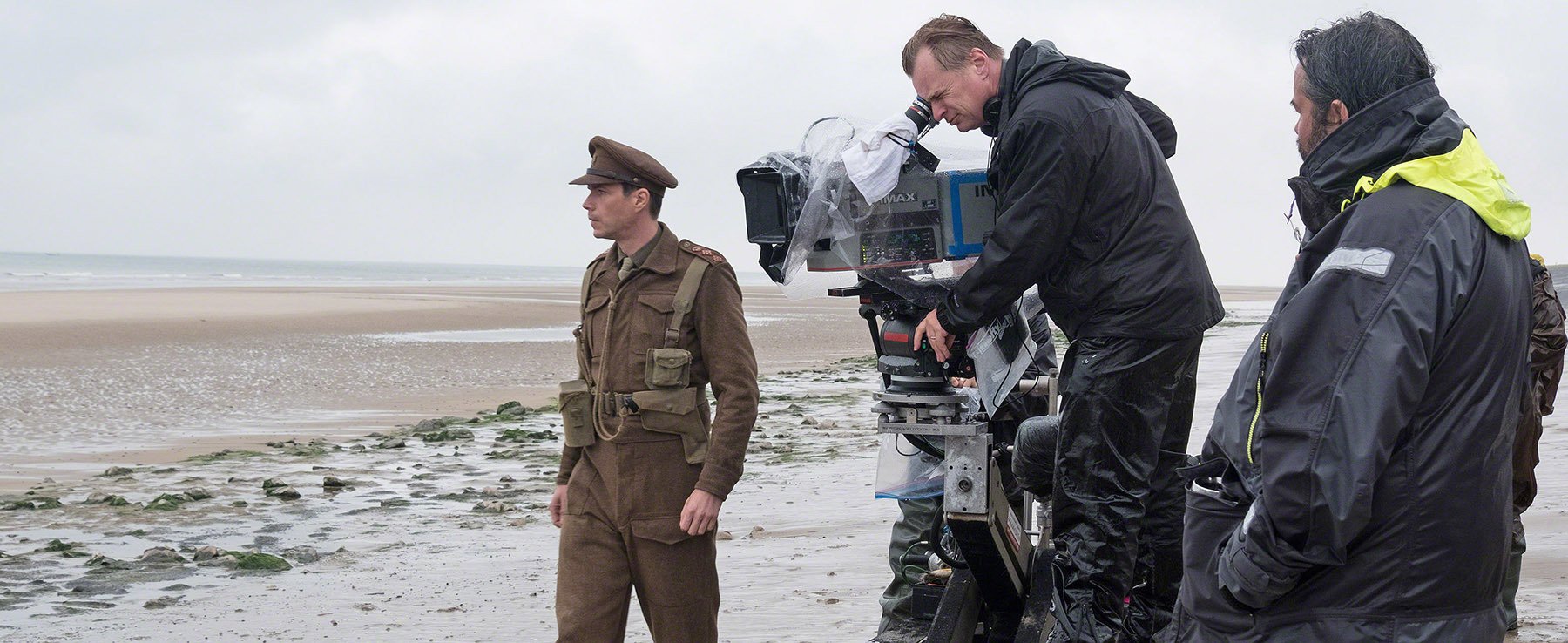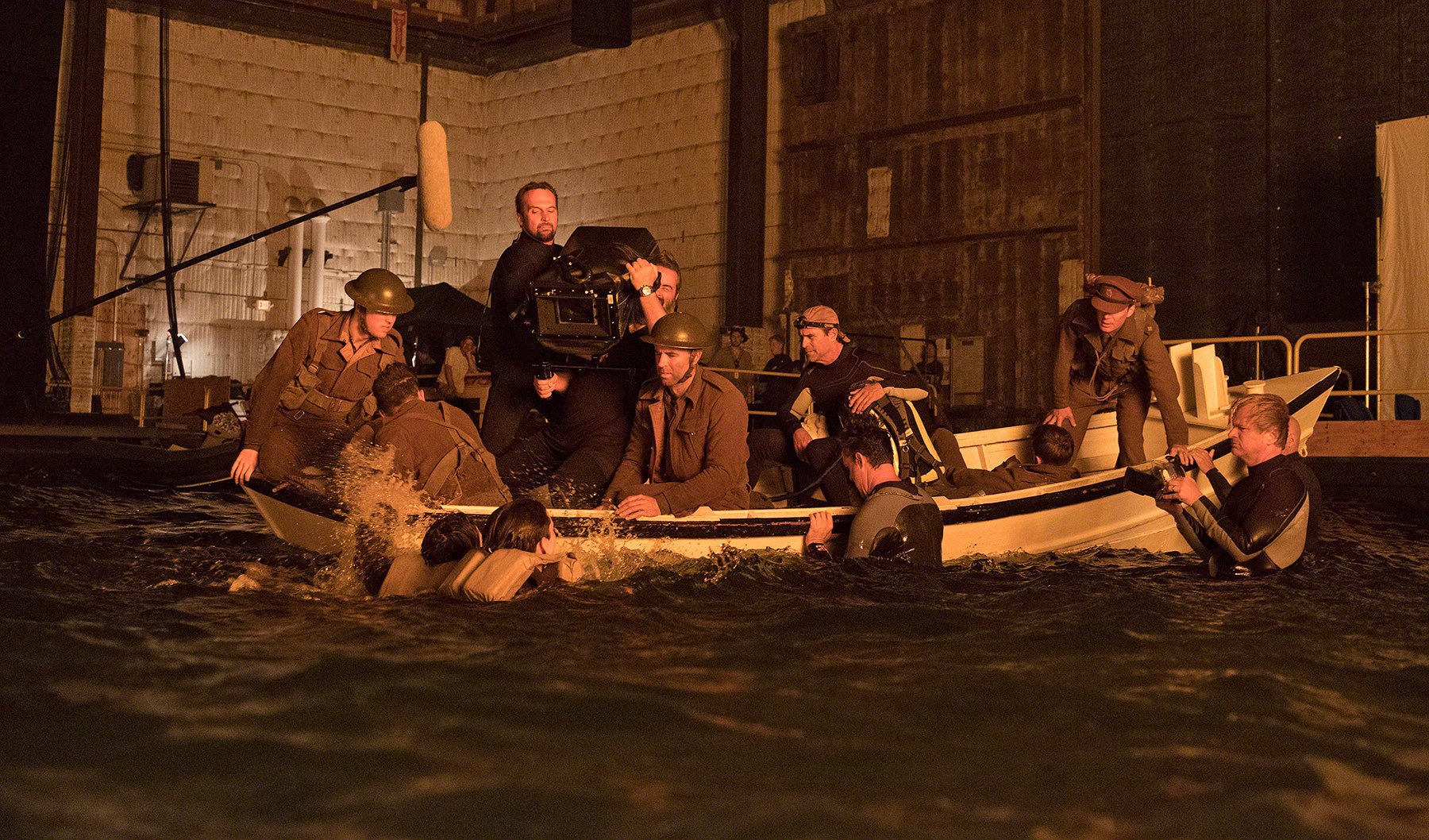
Dunkirk Post: Wrangling Two Large Formats
Detailing the photochemical workflow that combined 15-perf and 5-perf 65mm footage into a unified big-screen vision for the World War II epic.
Detailing the photochemical workflow that combined 15-perf and 5-perf 65mm footage into a unified big-screen vision for the World War II epic.
Unit photography by Melinda Sue Gordon, SMPSE, courtesy of Warner Bros. Pictures
Christopher Nolan’s desire to make sure that Dunkirk proved to be “the highest resolution feature film ever made” — as the director says in AC’s August cover story — required intense support from postproduction facilities Imax Post/DPK and FotoKem. Those companies were responsible for processing or manipulating hundreds of thousands of feet of 15-perf 65mm Imax and 5-perf 65mm motion-picture film and helping to shape it into a 1-hour-and-46-minute epic that has since been released in multiple formats — including, in about 100 theaters nationwide, 15-perf 70mm Imax.

As each facility coordinated its efforts with Nolan’s associate editor, John Lee, FotoKem had to use “all our expertise” to get the job done, according to Andrew Oran, the company’s vice president of sales and operations for large-format and restoration services. David Keighley, Imax Corp. chief quality officer and executive VP, emphasizes that the filmmakers shot “more than 975 rolls of 65mm, 15-perf negative for Dunkirk — close to the largest amount of Imax film ever shot for one of our movies.”

Unlike Nolan’s previous collaborations with Imax, the filmmaker decided this time to make all of the requisite Imax release prints from the original negative, without any dupe negatives involved. (An Imax interpositive was created as a protection backup.) In the end, all of Dunkirk’s release prints came from two master negatives, one 15-perf 65mm and one 5-perf 65mm.
Both masters contained duplicate-negative material of shots that were either blown up or reduced, depending on the format in which they had originated. FotoKem did the initial processing work for all of the movie’s 65mm negative — both 5-perf and 15-perf — while Imax Corp. took charge of negative cutting for the 15-perf 65mm version of the movie. After Imax supervised the creation and QC of the 15-perf answer print, all 70mm prints in both formats were then produced at FotoKem and printed on Kodak Vision 2383 stock.
Echoing Nolan, Keighley agrees that the end result is “probably the highest-resolution Hollywood movie ever put on screen. You have about 216 megapixels in an Imax frame, so if you add up all the Imax footage in this movie — which is the majority of the movie — you get 24-trillion pixels on the screen in the Imax version, which is astounding. Because it’s from the original negative, you are getting amazing clarity and detail in the film prints. And the material that is not Imax in the movie is 5-perf 70mm; that estimate of 24-trillion pixels does not even include the 5-perf.”

FotoKem was responsible for processing the project’s puzzle pieces in various combinations to eventually manufacture all the required deliverables. FotoKem’s areas of responsibility included all 65mm negative processing; making 5-perf 70mm prints from 5-perf 65mm footage, and screening those prints during production; providing 5-perf 65mm negative-cutting services; completing an answer print from the 5-perf 70mm and 15-perf 70mm versions; processing 35mm reduction prints from a 15-perf 65mm negative provided by Imax Post/DKP; providing 35mm and 70mm telecine transfers; creating interpositives, internegatives, check prints and Imax release prints; creating the movie’s DCP based on in-house color science designed to exactly match the film master; optically creating the anamorphic 35mm version; and generating all home-video deliverables.

According to Oran, 15-perf 70mm Imax release prints were struck directly from the original 15-perf 65mm cut negative, while 5-perf 70mm release prints were struck from a 5-perf 65mm duplicate negative. That dupe negative was manufactured by taking the 5-perf 65mm original camera negative through an interpositive/internegative dupe cycle. The 5-perf 65mm interpositive eventually became the source for both the digital cinema version of the movie and a 4-perf 35mm anamorphic duplicate negative, from which 35mm anamorphic release prints were struck.
“There are not many visual effects because [Nolan] likes to do almost everything practically, but any type of visual effect in the movie — even removal of wires and things like that — were all done at 6K.”
“One of the challenges was that the movie was shot 15-perf 65mm and 5-perf 65mm, but needed to be released in both formats,” Oran says. “That involved reducing optically the 15-perf content to 5-perf, and doing a widescreen extraction from the appropriate place within the 15-perf frame. They had framed and planned for that in camera, so usually we went to the same place on every frame and just reduced it. We made an optical-reduction interpositive right from the original camera negative for all 15-perf shots, resulting in a 5-perf duplicate negative, which could then be cut together with the 5-perf original negative to make a complete printed 5-perf negative. The reverse was true for the 15-perf 65mm version, where we took our 65mm multi-format optical printer and essentially reversed the setup on it, producing 15-perf internegative blowups from a 15-perf 65mm contact IP for all shots that originated in 5-perf.”

During the project, Imax-format film dailies were transformed into 4-perf 35mm reduction prints produced by Imax Corp. and then processed by FotoKem. In fact, Keighley says Imax was responsible for printing-down the hundreds of thousands of feet of 15-perf 65mm film shot with Imax cameras during production and screening that footage daily in order to provide technical reports to the crew on location. Imax also scanned all original 15-perf negative at 8K, as well as select original 5-perf negative at 6K; cut the negative for the 15-perf Imax version; created a 15-perf Imax protection interpositive; scanned the interpositive at 8K to produce digital data for the Imax laser- and xenon-projected versions of the movie; and recorded filmout negatives of all 15-perf visual-effects material at an almost unheard of 6K resolution.
“While we have always done our Imax visual effects at 5.6K, for this movie, we did them at 6K [6144x3072],” Keighley explains. “There are not many visual effects because [Nolan] likes to do almost everything practically, but any type of visual effect in the movie — even removal of wires and things like that — were all done at 6K.”
Beyond the 4-perf 35mm reduction prints, 15-perf 70mm Imax film dailies were periodically viewed during production, both on location in Europe and in Los Angeles. In addition, 5-perf 70mm contact prints produced by FotoKem were viewed overseas in the 2.20:1 aspect ratio inside a specially designed, remote 70mm-dailies-projection booth, while some 15-perf 70mm dailies were printed for viewing at selected locations in Europe and at the AMC CityWalk 19 Imax theater in Los Angeles.

Keighley jokes that when the filmmakers were on location, they watched “weeklies” instead of dailies given the average of four or five days needed to turn around the Imax footage. “With that longer turnaround, they relied on our crew back here, experienced people, to make sure that all the things you might look for — exposure, steadiness, no scratches or flicker, and so on — were dealt with,” Keighley explains. “Imax Post would view everything and then do the 35mm print-downs, while FotoKem handled all the 5-perf and then created editorial elements for Nolan [transferring 5-perf 70mm prints on a Millennium telecine at HD resolution]. They would cut together a work print for the 70mm team and a work print for the Imax team, with Imax cutting negative for all Imax material, combined with 5-perf material that FotoKem gave us. We called that the ‘5-15 negative,’ meaning 5-perf put into the 15-perf Imax format. Imax also filmed out a lot of the 5-perf visual effects, as well as the 15-perf visual effects.”

Keighley says the production’s ability to periodically view 15-perf 70mm dailies at the CityWalk cinema was “pretty special. We selected shots after Nolan studied the reduction print dailies — and then we did the prologue and all the sound testing at CityWalk,” he says. “We were looking at the movie on an 85-foot screen — and I can tell you, dailies at 85 feet are pretty special. It’s incredibly high dynamic range, as anyone going to see a 15-perf 70mm Imax presentation will notice. Since about 2000, whether projected on 70mm film or with xenon or laser projectors, all Imax films are projected at a 22 foot-lambert standard.”
“The great thing about the Imax film format is that it is the highest-resolution medium that has ever been developed.”
Meanwhile, throughout the process, FotoKem color timer and ASC associate member Dan Muscarella served as “guardian of the color,” in Oran’s words, pouring over every strip of film negative in both formats on a custom 65mm Colormaster color analyzer at FotoKem before anything was printed.
“The timing lights, the color information for both formats of film capture — they all came from the same color analyzer,” Oran says. “Dan Muscarella screened all contact and reduction prints to make sure that we were on track for color. It’s a real analog process, but completely relevant today, because the color always tracks. But it tracks because you have a human being — Dan Muscarella, in this case — making sure that it tracks, and then you have a paper record of the color-timing lights.”

Oran emphasizes that Dunkirk represents the largest and most sophisticated large-format project FotoKem has been involved with to date. “Since FotoKem implemented 65mm and 70mm services back in 2004, we have often provided services like this,” he says. “The last time we did a similar extraction, going from 15-perf to 5-perf, was on Interstellar [AC Dec. ’14], to create an optical duplicate negative on 5-perf so that film could be released in 70mm, working from Imax-format sources. In the case of that film, we also had 35mm anamorphic, but we had to make a blended duplicate negative. And that came before the work we did on The Hateful Eight [AC Dec. ’15], which was a complete 65mm-capture dailies-workflow project. Everything we’ve done on this movie is something we’ve done before, but we have never had one project that combined all our expertise across all departments like this one.”
Keighley adds that Dunkirk proves that the innovative use of large-format film acquisition for narrative Hollywood films can be pulled off elegantly in the digital era, and he praises filmmakers like Nolan for “keeping this artform alive.
“It can be done,” he emphasizes. “The great thing about the Imax film format is that it is the highest-resolution medium that has ever been developed. This movie shows it is an artform, and I hope a lot of people get to see it projected in 15-perf 70mm Imax. Christopher Nolan always calls it the gold standard.”







